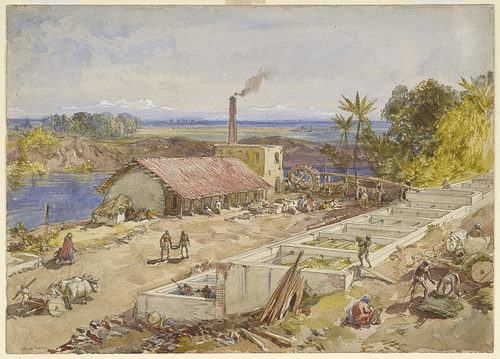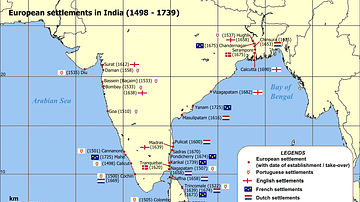
The Indigo Revolt (aka Indigo Riots or Blue Mutiny) of 1859-60 in Bengal, India, involved indigo growers going on strike in protest at working conditions and pay. The subsequent violence was aimed at exploitative European plantation owners, but the cause was, during and after, taken up by anti-colonial Indian liberals as an example of the necessity for independence.
The Indigo Trade
India was known for its cotton textiles through the Middle Ages, and by the mid-16th century Gujarat in northwest India was major a source of indigo, the deep blue-violet dye used to colour cotton and other materials. Indigo was in high demand by the European trading companies, including the British East India Company (EIC) which made large profits from its export. The EIC used well the long-standing expertise of Indian indigo growers and dyers, particularly in centres such as Sarkhej in Gujarat and Bayana in neighbouring Rajasthan, both in northeast India.
The making of indigo dye was a long and labour-intensive process. The plant cuttings were harvested once a year in June or July before the onset of the rainy season. These were then taken to a factory by cart where they were emptied into large vats to steep in water. The dyed water and mash was then boiled as this brought out a richer colour in the indigo grains, which then had to be strained out. The grains were next pressed into dried cakes, which were in turn pressed into barrels or, alternatively, the mass was cut into cubes and packed into chests ready for transportation. Most indigo was shipped to Calcutta (Kolkata) for sale to merchants who then organised shipment to England or the Americas where it was used to colour textiles. From the late 18th century, Bengal became the major centre for indigo production, accounting for 67% of London's total imports of the dye in 1796 (around 2 million kilograms) and then rising further into the 19th century.
The indigo industry was a volatile one. Too much or too little rain greatly affected the quantity and quality of the dye produced each year, and in boom years, overproduction brought a crash in the price. Still, for the long-term investor, indigo could be a very lucrative industry indeed. Unfortunately, the financial speculation that resulted in such a crop with potential for large gains was another source of instability. Finally, the location of many indigo plantations made them prone to flooding, which not only damaged the crop but often swept away the factory facilities.

Plantation Owners
Indigo plantation owners, many of whom had experience of running plantations in the West Indies, were one of the few categories of settlers the East India Company allowed into its territory in India. This was because the agricultural land was already densely populated but indigo was such a lucrative trade that indigo investors became an exception. Even so, unlike in the plantation systems seen in, for example, the West Indies, indigo plantation owners in EIC-controlled India could not own the land. Most indigo plantation owners merely rented the land upon which their crops and production facilities were situated. After 1837 and the relaxation of EIC regulations, some plantation owners began to buy or lease land.
The plantation owner permitted parcels of the land he himself rented to be cultivated for indigo by local peasant farmers, known in this case as ryots. These small-scale indigo growers, who would oversee and provide the crop when the production season came around, did not pay rent to the owner but received his capital investment to grow the crop. In return for the investment, the grower promised to sell to the plantation owner a certain quantity of indigo at a certain price at a future date. This system was particularly prone to the volatile market problems mentioned above, and it meant that relations were not particularly good between owners and growers – the historian D. Gilmour describes these 'industrial relations' as "the worst in India" (217).
Typically living on isolated farms, there were only around 200 European plantation owners in India. They were a breed all on their own, living in huge bungalows and pursuing a life of ease when not harvest time. They played polo, went boar hunting, kept elephants, and took frequent drinks at all times of day except siesta, indeed it was not uncommon to ride many miles on horseback to reach a fellow planter or urban area for one of the many parties that brightened up the winter season. The visiting magistrate Gerald Ritchie gives the following summary of their general character: "rough, daring, practical colonists…[they were] great heroes in their own eyes…[with] an unpleasant note of excessive self-assertion and bravado" (Gilmour, 215-16). The travel writer Emma Roberts (1791-1840) gave a similar insight, noting the "barbaric grandeur" (ibid, 221) in which these owners lived far from home.
Causes of the Indigo Revolt
Trouble in the indigo industry began in the mid-19th century when there was a global economic slump which caused the price to plummet. To recoup money lost on contracts, the small-scale cultivators of indigo were now squeezed into producing dye material as they had always done, but at 30-50% of the market price. In addition, middlemen who collected the contract revenues on behalf of owners often asked for their own cut, further increasing financial costs for the growers. Those cultivators who resisted the price controls suffered intimidation, beating, and even eviction from the plantation. There were also accusations of murder. Neither were growers permitted to cultivate more lucrative food crops like rice since these were only valuable locally and could not be exported for profit to Europe. There was often no legal redress as the European plantation owners knew full well that they were not bound by the local law courts and colonial magistrates seldom went beyond giving out paltry fines and a warning not to maltreat their workers in the future. Another problem was that many of the plantation owners had made so much money, they had already retired to Britain but to keep their source of income going they had hired estate managers, typically picked specifically for their intolerant attitude and tough, intimidatory style of management.
At first, the indigo growers pursued a non-violent approach – they simply refused to grow more indigo, deliver on their contracts, or sign any new contracts with owners. As one planter stated, he would "rather beg than sow indigo" (Bhattacharya, 14). Another strategy was to make life difficult for the Indian servants of plantation owners by ensuring villagers did not supply them with essential food and services. Some owners responded by suing the growers for breach of contract or by sending in armed guards to coerce the growers, but this typically ended only in violent clashes where even women were involved. Tensions rose to such a fever pitch that there was an explosion of violence in April 1860 as the growers organised themselves into armed groups or paid others to fight for them. In the rioting, indigo crops were wrecked, plantation buildings were burnt down, and plantation owners themselves were attacked and members of their staff killed. The riots were uncoordinated and much depended on how ryots viewed their individual plantation owners. For these reasons, some areas saw little violence while in others the prisons were packed.
The Indigo Riots were really about a broken feudal system and economic exploitation, but the events were soon latched on to by the anti-British press and Indian middle classes in Calcutta, who saw an opportunity to highlight anti-British sentiment in India in general. They hoped for an escalation like the Sepoy Mutiny of 1858, also in Bengal, when disgruntled Indian soldiers of the East India Company had risen in anger and then been joined by people of all classes and some rulers of the Indian princely states. In reality, though, the indigo rioters were fighting about a single issue and they were not joined by other peasants growing other crops. The rioters had one target only – the plantation owners – and they did not attack either representatives or the institutions of the British colonial government.
Reaction & Support
The authorities eventually quashed the riots, and an Indigo Inquiry Commission was established to investigate the failings of the industry. The Bengalese did not forget. Dinabandhu Mitra (1830-1873), a Bengalese postmaster and railway inspector, wrote a play in 1860 based on the 'Blue Mutiny', his Nil Darpan ('The Blue Mirror'). This play was a great success and is considered one of the earliest and most important works of Bengali theatre. The play was translated into English by James Long, an Irish missionary, but Long was imprisoned for one month as a result – the authorities claiming he had slandered indigo plantation owners. In 1860, the Indigo Act was passed, and it was now illegal for British plantation owners to oblige tenants on their land to grow indigo. On the other hand, in 1866, a new law concerning contracts was devised to cover such refusals to fulfil contracts as had been seen by the indigo ryots.
There were more indigo-inspired riots just a decade later, particularly in the Bihar state in the middle Ganges valley. The indigo workers seemed destined for never-improving working conditions. As late as 1917, the plight of indigo workers was highlighted by the leader of the Indian independence movement Mahatma Gandhi (1869-1948) who conducted one of his non-violent satyagraha (civil disobedience) campaigns at Champaran in Bihar specifically in response to the plight of indigo growers there. The indigo industry was by then already a severely endangered one. At the end of the 20th century, a synthetic indigo dye had been invented in Germany, and this was much cheaper to produce, even if less brilliant than the real thing. Ultimately, the European and Eurasian indigo plantation owners moved on elsewhere to grow other crops like coffee, tea, and rubber, while the old processing plants and mansion houses were left to decay and be reclaimed by the jungle.







